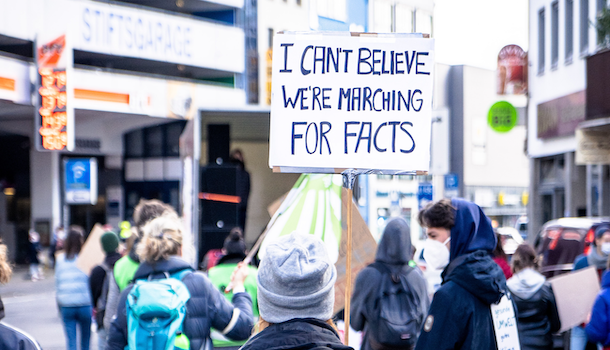Fake news in its varied forms is costing the global economy some $78 billion a year.
By Faisal Hoque
The film A PERFECT STORM captured the catastrophic consequences of a fishing boat caught in a confluence of deadly weather. However unlikely, these factors came together to produce a once-in-a-lifetime storm. It was all too real.
The problem of misinformation is a perfect storm in its own right. Given technology’s capacity to deliver and share “news” of all sorts, people can now be bombarded with a constant hail of information—so-called infostorms. Like a real storm, the consequences of intentional misinformation are devastating—and they may only be growing worse and more pervasive.
FAKE NEW PREYS ON SHEEP
Media as a whole has come under suspicion. According to a recent study, almost half of the nearly 6,000 American college students surveyed said they lacked confidence in discerning real from fake news on social media. And 36 percent of them said the threat of misinformation made them trust all media less.
Misinformation is anything but purely political. From the idea that consuming bleach can kill the virus to the still-breathing “theory” that the virus was created in a laboratory as a biological weapon, the COVID-19 pandemic has generated a flurry of misinformation. In fact, a report in the August 10, 2020, edition of the American Journal of Tropical Medicine and Hygiene estimated that the pandemic has fostered more than 2,300 conspiracy theories, rumors, and other forms of misinformation. In the first three months of 2020 alone, nearly 6,000 people worldwide were hospitalized because of coronavirus misinformation, recent research suggests. During this time frame, researchers say at least 800 people may have died due to misinformation related to COVID-19.
When then-president Barack Obama first proposed widespread health-care reform, a concomitant suggestion posited elsewhere was the idea that elderly people would have to consult with “death panels” to discuss end-of-life options such as euthanasia. A poll conducted by the Pew Center in August 2009 found that 30 percent of the public thought the “death panel” rumor was true, with another 20 percent unsure of the legitimacy of the statement.
AND, FAKE NEWS IS BECOMING HARDER TO RECOGNIZE
Subsequent research following the landfall of Hurricane Sandy in 2012 found more than 10,000 tweets containing fake images of the hurricane. It’s not difficult to speculate that distribution of this false information could have led to poor understanding of the severity of the storm, as well as potentially inadequate or misguided safety precautions.
To complicate matters even more, the “next generation” of fake news has arrived. Now, audio and video created and altered to accompany and boost content can make disinformation seem all the more legitimate—and more difficult to disprove. Even people unskilled in computer technology can use free, easy-to-use apps to do everything from swapping out one face for another to mimic certain facial features, to cloning speech patterns to produce fake audio that sounds just like a real person.
EXPEDIENT LAZINESS IS ONE TO BLAME
Misinformation is simply becoming more and more widespread. In March 2020, it was reported that nearly 30 percent of US adults believed the Chinese government created COVID-19 as a bioweapon. In a study published a month later, 25 percent said they believed the outbreak was intentionally planned by authorities. In a rare bright spot, the COVID-19 pandemic has helped fuel legislative action against fake news throughout the world. From Algeria to Vietnam, a number of countries passed “fake news” regulations during the COVID-19 outbreak.
However, not to be understated, the associated costs of combatting and counteracting disinformation is substantial. According to a 2019 study by Israel-based cybersecurity firm CHEQ and the University of Baltimore, fake news in its varied forms is costing the global economy some $78 billion a year.
So, why do we continue to overlook the problem? Why are so many people reading and believing all sorts of misinformation?
One possible explanation is referred to as “expedient laziness.” Presented with news or information that often requires corroboration, many might groan at the thought of plowing through other sources and sifting through claims and counterclaims. It’s far easier and faster simply to ask others what they think—while gaining a degree of social acceptance by simply going along with the crowd.
THE SOLUTION IS IN THE STRATEGIES
Ultimately, the overriding challenge facing society is the vital importance of rebuilding trust in fact-based, objective decision-making, be it regarding technology, public health issues, or a planet that continues its exponential warming. Only then will the vast opportunities embedded in these dynamic forces of change be fully realized. And the stakes of capturing that opportunity as fully as possible are very, very high.
Here are 4 strategies for combating the damaging effects of fake news:
1. Experiential Learning – Research from the Reboot Foundation found that interventions as simple as reading a short article or watching a three-and-a-half-minute-long educational video on spotting fake news can make an immediate difference in test subjects’ abilities to pinpoint erroneous material of all sorts. Rather than just hearing about fake news, using experiential learning—such as quizzes and other tools where readers are asked to select which is real and which is not—can equip people of all backgrounds to proactively look for certain types of phrases, wording, and other signs that the information they’re seeing may not be genuine.
2. Systematic thinking – Whether within the confines of formal education or personal skill development, systemic thinking is absolutely essential to the growth of greater media literacy. Some core ideas to bear in mind are as follows:
- What is the source of the information? Established news medium or an anonymous source?
- Does it have statistics from a reputable, known source? Does it contain quotes from a subject expert?
- Do phrases such as “reports suggest” hint that there’s nothing genuinely credible about where the information came from?
- Are certain details omitted? For instance, in an obituary, does the article lack cause of death? Although these are frequently left out to protect privacy, credible sources generally add the phrase “no cause of death was given” or some other explanation.
- How did the information make you feel? Angry? Upset? Con- fused? Do you think that was the author’s actual intent?
3. Empathy – Approach misinformation and fake news with a sense of empathy toward others—not for people attempting to pull off such scams but for others who may be unwittingly taken in by misleading or potentially dangerous falsehoods. Let the person posting the material know that you believe it to be false and cite your reasoning for doing so. Cite the questions and other means of investigation you used to identify the false posting. Treat those who believe the fake news with an understanding of how easy it can be to fall for such mischief.
4. Fact-checking websites – These third-party websites provide a quick and accurate way of investigating all sorts of media that come across as suspicious. They include:
- AP Fact Check, Associated Press
- Factcheck.org
- PolitiFact
- The Washington Post’s Fact Checker
- Flackcheck.org
We must all agree and understand that advancing technologies like AI and others will keep misinformation a central part of our lives for the foreseeable future. In order to safeguard our health, our economy, and our planet we must be openly aware of fake news and its proliferation and vigilant on how we perceive it. Our lives depend on it.
© 2022 by Faisal Hoque. All rights reserved.
This article is adapted from the #1 Wall Street Journal and USA Today best selling book LIFT by Faisal Hoque.
[Photo by Mika Baumeister on Unsplash]
















